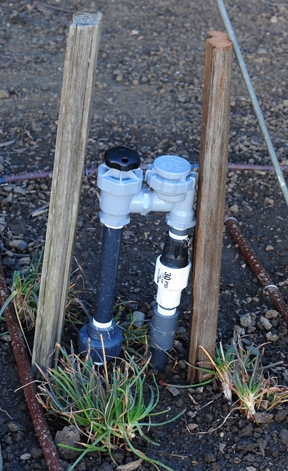UC Blogs
Signs of Life on a Passionflower Vine
If you have a passionflower vine (Passiflora), check to see what insects or stages of insects are making this plant their home. A frost-bitten...
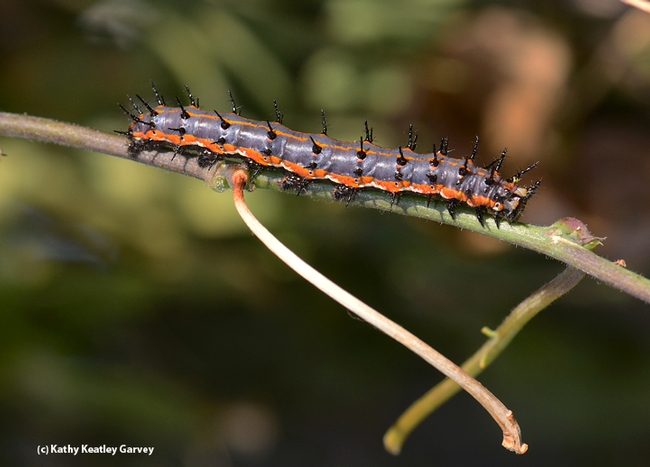
A Gulf Fritillary caterpillar crawling on a stem. (Photo by Kathy Keatley Garvey)
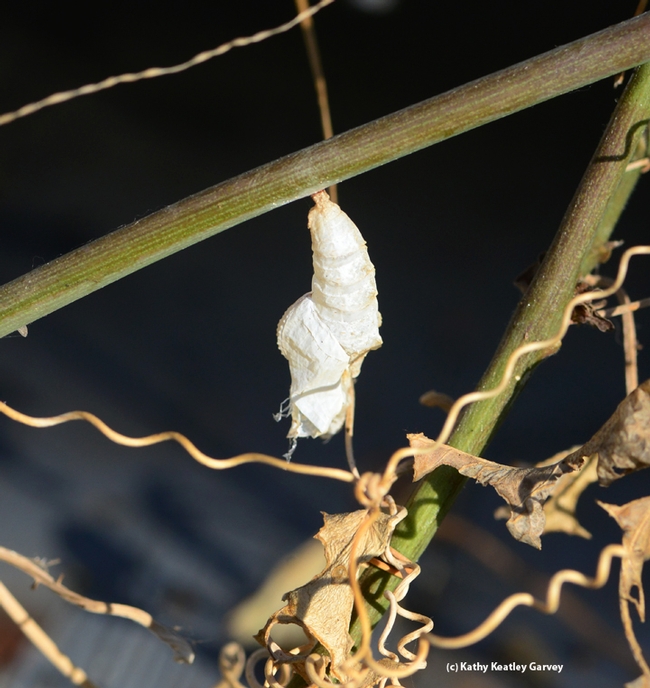
An empty chrysalis: a Gulf Fritillary butterfly had earlier emerged. (Photo by Kathy Keatley Garvey)
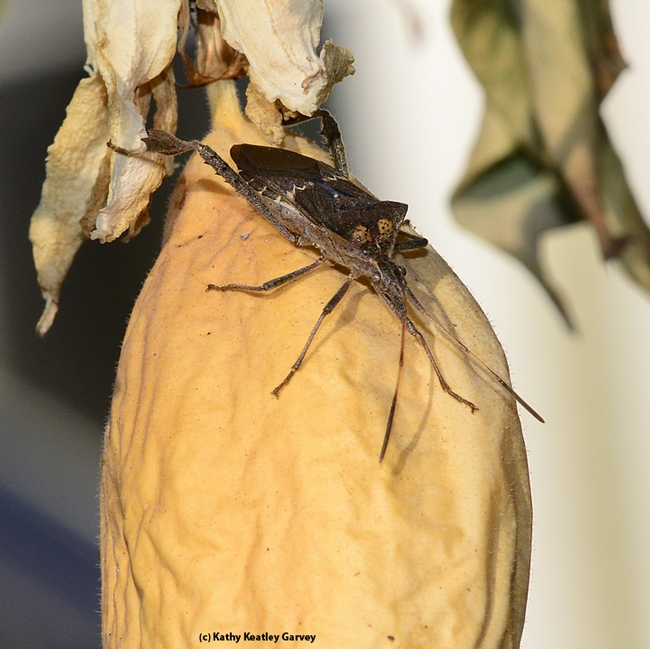
A leaffooted bug on the seed pod of a passionflower vine. (Photo by Kathy Keatley Garvey)
Pistachio: New drought stress, salt tolerance and chill requirement publications
A search of Web of Science revealed a few new publications on drought stress and salt tolerance in Pistachio. I copied the citations, abstracts, and...
How does your garden grow? In a drought, consider drip
Mary, Mary, quite contrary
How does your garden grow?
--English nursery rhyme
How will your garden grow during California’s drought emergency? Gov. Jerry Brown says the state is facing the worst drought in its recorded history.
We urban gardeners may turn quite contrary if our gardens don't grow.
Alternative: Consider installing a drip irrigation system.
Why a drip system? It’s target watering. It’s uniform watering. It’s non-wasteful watering. You don’t want to water the leaves, the space between the plants, or worse, water the sidewalk or let the water gush into the gutter.
Drip irrigation is better for plant health. Plants thrive with drip because it waters them slow and deep where the roots are. You’ll likely minimize weed growth. In comparison to overhead sprinklers, the smaller, targeted area means that weeds will have less opportunity to spring up and try to take over your garden, Gangnam Style. And by not watering the leaves of your plants or allow them to collect standing water, you can reduce diseases.
Drip irrigation is simply a network of pipes, tubing, valves and emitters. Water “drips” or “trickles” directly to the roots.
The concept is not new. Back in the first century, Fan Sheng-Chih Shu wrote about what we now consider a “primitive” drip irrigation system, but one that definitely worked well: Farmers buried perforated unglazed clay pots and filled them with water. They refilled them as needed.
Today’s modern drip irrigation system for urban gardeners includes an irrigation controller with automatic valves or a manual system (shown). If it's automatic, a timer controls the valves and waters the plants while you do something else - like enjoying a glass of lemonade on the back porch, watching your favorite movie, or vacationing in Hawaii. Note: It's a good idea to set your timer for early in the morning, before 8. There's less evaporation.
Of course, there can be disadvantages to the drip system. The key disadvantages are the initial cost of the equipment and labor. Then, too, you must closely monitor the system to ensure the emitters aren’t clogged, or thirsty rodents aren’t gnawing through your plastic pipes.
Find more about drip irrigation on the Sonoma County Master Gardeners website.
Bottom line: A drip irrigation system is often a better alternative to overhead sprinklers or the hand-watering method. Expect to conserve water, save on your water bill, grow healthy plants with fewer weeds and diseases, and save time and effort in doing so.
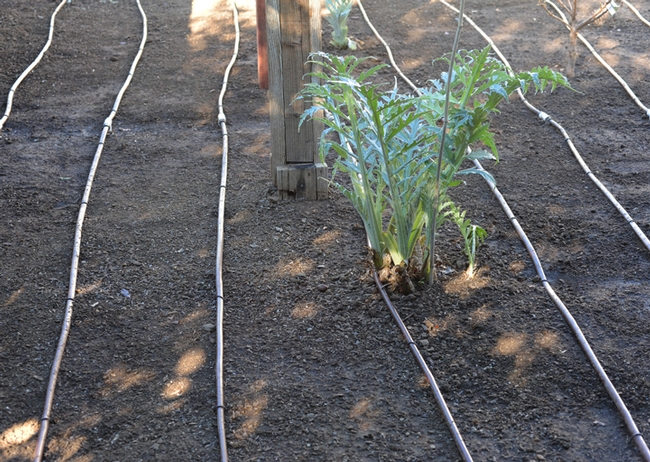
An artichoke in the drip grid. This area is ready for planting. (Photo by Kathy Keatley Garvey)
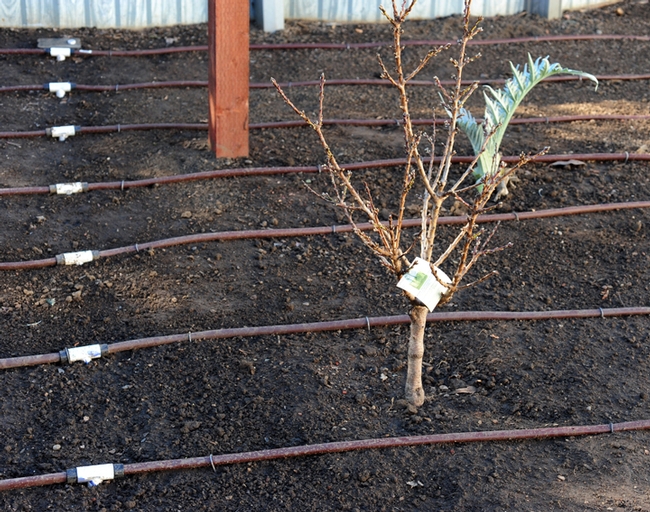
A newly planted peach tree among the drip lines. (Photo by Kathy Keatley Garvey)
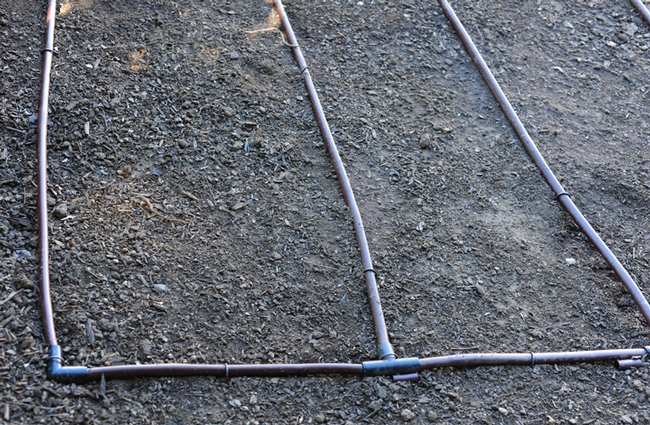
Corners of the drip grid. (Photo by Kathy Keatley Garvey)
Visit to the Marin Art & Garden Center
I was visiting Marin during the holidays and learned of the Marin Art & Garden Center located in Ross that happened to be en route. Unfortunately, I chose the wrong time of year to visit and the attached pictures reflect that (i.e., most of the plants are dormant for the winter). However, it is easy to see how beautiful these gardens will look, come spring, at which time, I plan to re-visit.
The gardens include notable trees (including a historic giant sequoia tree, a large English oak tree, a magnolia tree dating back to 1870), a butterfly habitat garden, a memory garden, a native basketry garden, a rose garden, an herb and medicinal garden, and a succulent and native plants garden. The National Wildlife Federation has designated the gardens, which are a pesticide-free zone, as a Habitat Sanctuary, which means that the property was/is planted such that it provides food, water, cover, and places for wildlife (birds, bees, beneficial insects, etc.) to hide and raise their young. As part of its integrated pest management and rodent control practices, the gardens participate in the Hungry Owl Project (HOP) and place owl boxes throughout the garden where barn owls can nest.
Sculpture is also integrated in the garden. My favorite of these includes a whimsical unicyclist toting a bottle of wine on his bike (see attached picture).
Although the Marin Art & Garden Center features themes similar to other gardens I have written about in this blog, it is very different in that the gardens share space with the local school district's offices, an antique store, various historical buildings, a theater, and a reference library which houses the Ross Historical Society. There is also a very unique, hobbit-like structure at the site called the Bottle House. There was not a plaque describing this building's purpose or history. I can only assume this structure was dubbed the "Bottle House" because some of the "windows" are made out of the bottoms of colored glass bottles. The gardens are maintained by volunteers, including the Marin County Master Gardeners. It is a lovely space worthy of a visit when all is in bloom. Admission is free and it is open daily from dawn to dusk. For further information, please see http://www.magc.org.

Riparian Habitat with Bottle House in the Background. (photos by Betty Homer)
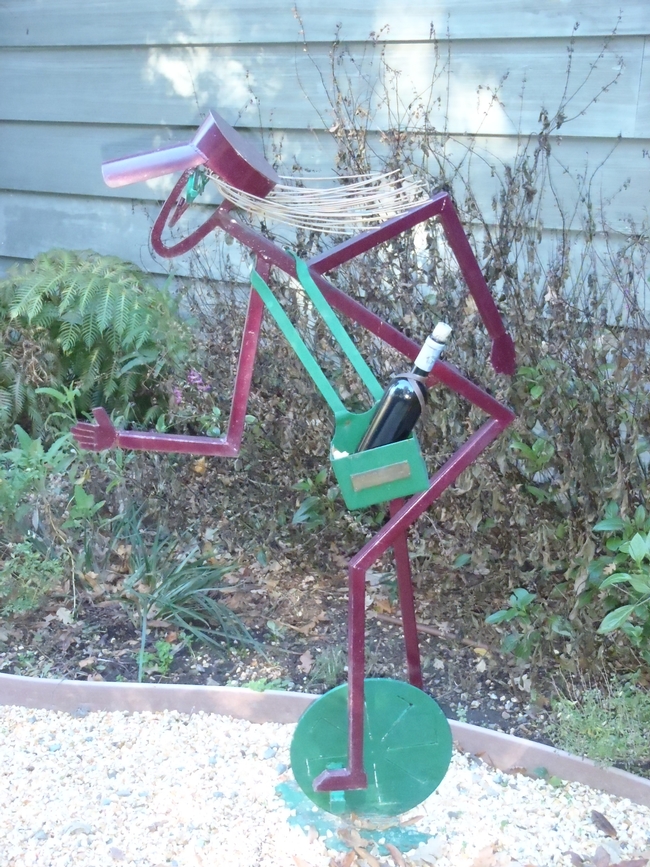
Sculpture of a Unicyclist Toting a Wine Bottle.
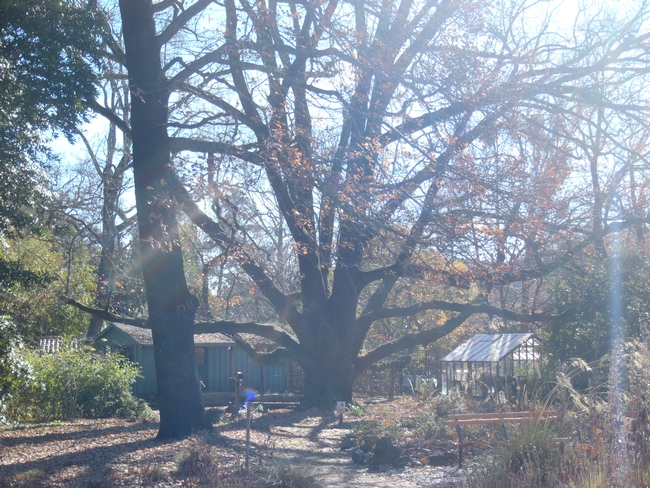
Great English oak.
Thoughts for a Monday
Not only is a Monday, but the 13th of the month besides! Does that qualify for a double whammy, or what? For me, it’s a day to plan for the rest of the week and think back to the past weekend.
This last weekend we went to Sacramento to attend a “seconds” art sale. I found a few ceramic and glass pieces that requested a ride back to Suisun City with me, but I somehow kept my money in my purse. Perhaps it was Bruce’s scowl at more things to hang on already drooping walls OR crowded walkways between venders. Anyway, I walked out with empty hands.
But then I saw the prize! In front of the art and garden center was a magnificent stand of camellia bushes – almost tree-sized –the one lording over a mulch of bright pink petals! That bush was covered in 3-inch single pink blooms, just like the ones shown in catalogs. If only I had a small army of men with shovels! That’s what I wanted in my side yard; but, alas, too many people, no shovels, and a husband giving me the “dagger” stare. Heck, I didn’t even have my camera!
Right now, Sacramento is full of color: rhodies (rhododendrons), camellias, and other late winter/early (very) spring blooming trees and shrubs! McKinley Park was full of people walking, running and just hanging out – it was a beautiful day. It was a real change from my area of Suisun, where the yards are quite brown, dead-looking really, except for the spring grasses sprouting up.
This late October, we sprayed pre-emergent to halt the spring weed tide in the back and side yards. Next month, will re-spray the same areas to hold up the summer and fall weed crops. It’s much easier to try to prevent weeds than fight them “on the root” so to speak.
As to my “war on Bermudagrass”, I’ve managed for now tore claim two raised beds made of reclaimed concrete and the 12X12 wooden raised bed; but, that’s for now! With the help of weed-eaters, grass-killers, and just plain hand-pulling, I hope to keep seeing this area and even more by mid-summer!
I’m off to find more drip irrigation leaks and other items that have been hidden. Would you believe a found a small seal sculpture in one of those beds? And I just know I have a rain gauge (do I really need it now?) hidden elsewhere! This is going to be a real treasure hunt! See ya!


